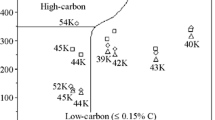Conclusions
-
1.
The structure of cold-rolled strip (ε=97%) of hard magnetic Fe−Cr−Ni steel of the 18-9 type was examined in thin foil by means of transmission electron microscopy. Three elements of the structure occurring simultaneously were discerned — a biphase banded structure, biphase regions of fine fragments, and untransformed austenite. The sizes of these individual structural components were estimated.
-
2.
It was concluded on the basis of the structural elements and electron-diffraction data that crystals of strain martensite are grouped in packets with interlayers of austenite during rolling of 18-9 steel.
-
3.
It is possible for the isothermal martensitic transformation to occur in hard magnetic 18-9 steel during slow cooling from austenitizing temperature and rest.
-
4.
It follows from an analysis of the dilatometric curves and measurements of the saturation magnetization that additional γ→α transformation may occur in cold-worked 18-9 steel during tempering at temperatures of 370–380°. Equiaxed particles of austenite free of dislocations are formed beginning at 480° and the original cold-worked structure is polygonized in the process of heating.
Similar content being viewed by others
Literature cited
I. Ya. Sokol, Biphase Steels [in Russian], Metallurgiya, Moscow (1974).
A. Schaeffler, Met. Progr.,56, 680 (1949).
G. Rasman and O. Henkel, Ber. Arbeitsgem. Ferromagn., 120 (1958).
M. N. Raevskaya, "Metallic magnetic carriers for recording," Izv. Akad. Nauk SSSR, Ser. Metall. Toplivo, No. 4, 114 (1959).
M. N. Raevskaya et al., "High-strength stainless wire and bands of Fe−Cr−Ni alloys," Stal', No. 6, 563 (1971).
G. Rasman and O. Henkel, Z. Angew. Phys.,14, No. 4, 245 (1962).
J. Venables, Philos. Mag.,7, 35 (1962).
P. Kelly and J. Nutting, J. Iron Steel Inst.,197, No. 3, 199 (1961).
R. Lagneborg, Acta Met.,12, No. 7, 823 (1964).
D. Goodchild, W. Roberts, and D. Wilson, Acta Met.,18, 1137 (1970).
B. China, J. Iron Steel Inst.,177, No. 4, 406 (1954).
I. Ya. Sokol and I. V. Gorbatenko, "Improvements in the technology and production of bands from maraging steel ÉI814," Stal', No. 11, 1036 (1971).
F. F. Khimushin, Stainless Steels [in Russian], Metallurgiya, Moscow (1967).
Additional information
I. P. Bardin Central Scientific-Research Institute of Ferrous Metallurgy. Translated from Metallovedenie i Termicheskaya Obrabotka Metallov, No. 6, pp. 8–12, June, 1978.
Rights and permissions
About this article
Cite this article
Lur'e, S.A., Potapov, N.N. & Demin, E.A. Structure and phase transformations in cold-worked Fe−18Cr−9Ni steel. Met Sci Heat Treat 20, 440–444 (1978). https://doi.org/10.1007/BF00773980
Issue Date:
DOI: https://doi.org/10.1007/BF00773980




